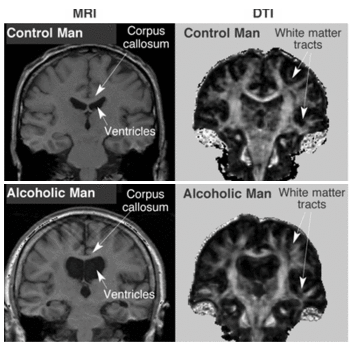Alcoholism: Difference between revisions
imported>Michael J. Formica (Organizational structure) |
imported>Richard Pettitt (added image) |
||
| Line 1: | Line 1: | ||
{{subpages}} | {{subpages}} | ||
[[Image:Mri alcohol.gif|right|thumb|350px|{{#ifexist:Template:Mri alcohol.gif/credit|{{Mri alcohol.gif/credit}}<br/>|}}Images of a 61-year-old healthy man (upper images) and a 60-year-old alcoholic man (lower images). Note on the MRI the thinner corpus callosum displaced upward by enlarged ventricles and, on the DTI, less well delineated white matter tracts in the alcoholic man compared with the healthy man.]] | |||
'''Alcoholism''' is a chronic condition, the development and presentation of which is influenced by [[genetic]], [[psychosocial]], and [[environment|environmental]] factors. As a [[disease]] process, it is often progressive, and sometimes [[death|fatal]]. Alcholism is typically characterized by impaired [[impulse control]], preoccupation with [[alcohol (drug)|alcohol]], continued use of alcohol despite adverse consequences, and a generalized distortion in thinking. While the condition itself is considered chronic, the symptom profile may present either continuously or periodically." <ref name="title">{{cite web |url=http://www.nlm.nih.gov/cgi/mesh/2007/MB_cgi?term=Alcoholism |title=Alcoholism |author=National Library of Medicine |accessdate=2007-12-06 |format= |work=}}</ref> | '''Alcoholism''' is a chronic condition, the development and presentation of which is influenced by [[genetic]], [[psychosocial]], and [[environment|environmental]] factors. As a [[disease]] process, it is often progressive, and sometimes [[death|fatal]]. Alcholism is typically characterized by impaired [[impulse control]], preoccupation with [[alcohol (drug)|alcohol]], continued use of alcohol despite adverse consequences, and a generalized distortion in thinking. While the condition itself is considered chronic, the symptom profile may present either continuously or periodically." <ref name="title">{{cite web |url=http://www.nlm.nih.gov/cgi/mesh/2007/MB_cgi?term=Alcoholism |title=Alcoholism |author=National Library of Medicine |accessdate=2007-12-06 |format= |work=}}</ref> | ||
Revision as of 23:54, 27 December 2007

Images of a 61-year-old healthy man (upper images) and a 60-year-old alcoholic man (lower images). Note on the MRI the thinner corpus callosum displaced upward by enlarged ventricles and, on the DTI, less well delineated white matter tracts in the alcoholic man compared with the healthy man.
Alcoholism is a chronic condition, the development and presentation of which is influenced by genetic, psychosocial, and environmental factors. As a disease process, it is often progressive, and sometimes fatal. Alcholism is typically characterized by impaired impulse control, preoccupation with alcohol, continued use of alcohol despite adverse consequences, and a generalized distortion in thinking. While the condition itself is considered chronic, the symptom profile may present either continuously or periodically." [1]
Alcoholic styles
Chronic drinking
Maintenance drinking
Binge drinking
Blackout drinking
Recovery styles
The 'dry drunk'
In recovery
Post-recovery
Treatment
Medications
Baclofen
Baclofen is a a selective GABA B-receptor agonist that in a single trial of patients with alcoholic cirrhosis improved abstinence rates (71% versus 29%) over three months.[2]
Disulfiram
A randomized controlled trial showed benefit from disulfiram [3]
Topiramate
A randomized controlled trial of volunteers showed benefit from topiramate.[2]
Naltrexone
Randomized controlled trials show conflicting benefit from naltrexone with benefit among recent abstainers[4] and no benefit from chronic users[5].
See also
References
- ↑ National Library of Medicine. Alcoholism. Retrieved on 2007-12-06.
- ↑ 2.0 2.1 2007. Lancet Cite error: Invalid
<ref>tag; name "pmidpending" defined multiple times with different content - ↑ Fuller RK, Branchey L, Brightwell DR, et al (1986). "Disulfiram treatment of alcoholism. A Veterans Administration cooperative study". JAMA 256 (11): 1449–55. PMID 3528541. [e]
- ↑ Anton RF, O'Malley SS, Ciraulo DA, et al (2006). "Combined pharmacotherapies and behavioral interventions for alcohol dependence: the COMBINE study: a randomized controlled trial". JAMA 295 (17): 2003–17. DOI:10.1001/jama.295.17.2003. PMID 16670409. Research Blogging.
- ↑ Krystal JH, Cramer JA, Krol WF, Kirk GF, Rosenheck RA (2001). "Naltrexone in the treatment of alcohol dependence". N. Engl. J. Med. 345 (24): 1734–9. DOI:10.1056/NEJMoa011127. PMID 11742047. Research Blogging.